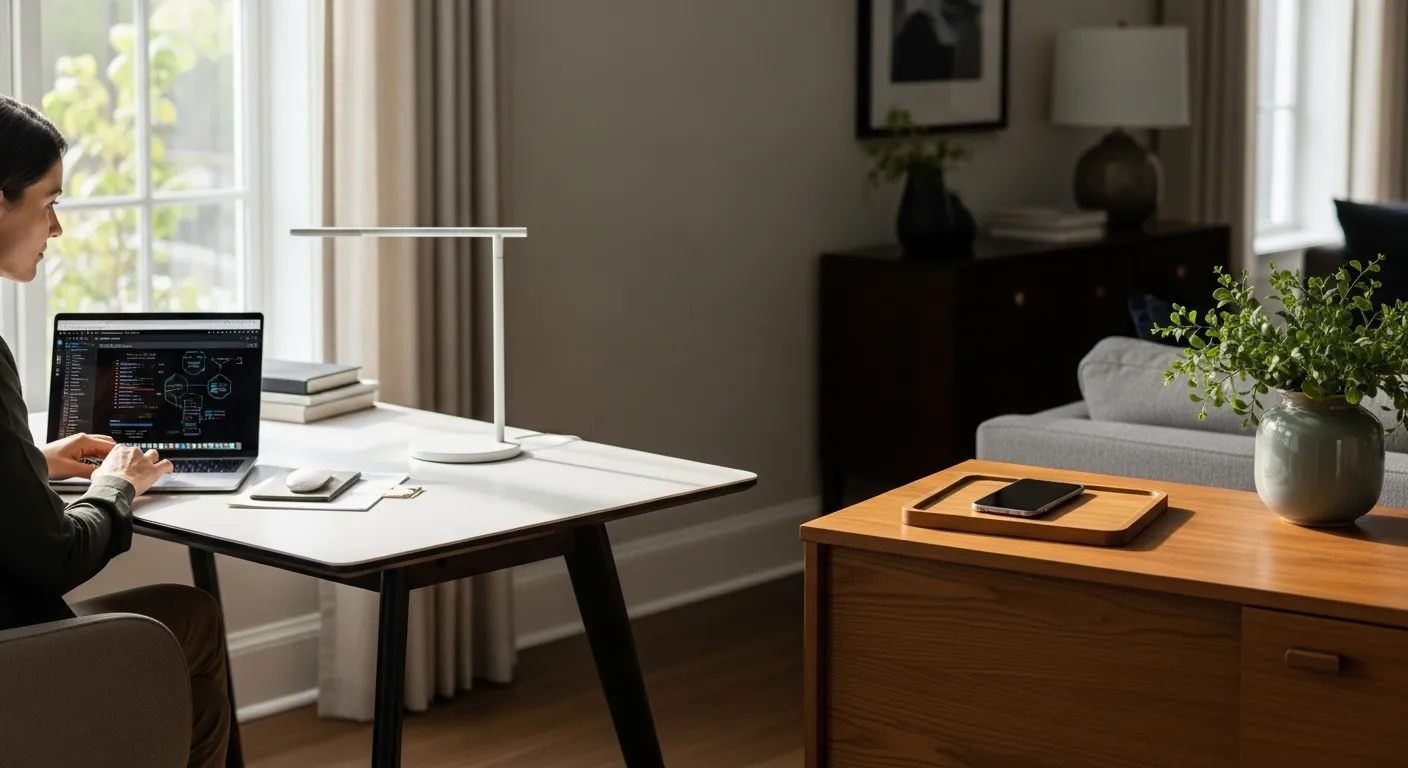
You’ve tried it all. The heroic, white-knuckle approach to productivity. The weekend planning sessions that result in a color-coded, minute-by-minute schedule you abandon by Monday at 10 AM. The sprint-and-crash cycle that leaves you feeling more exhausted than accomplished. Here’s a secret the most productive people understand: monumental effort is fragile. Sustainable systems, on the other hand, are antifragile. They bend without breaking.
Your smartphone, often painted as the villain in your productivity story, holds one of the most powerful, underutilized systems available to you. It’s called Focus Mode. This isn’t just a glorified “Do Not Disturb” button. It’s a dynamic, context-aware shield you can build around your attention. When used correctly, it’s not about turning your phone off; it’s about turning your focus on.
This guide will show you how to transform your phone from a source of constant distraction into a precision tool for deep work. We won’t just cover the “what,” we will dive deep into the “how” and “why.” We’ll move beyond the basic settings and explore how to weave this feature into a larger, more resilient productivity system. Forget willpower. It’s time to build a better system, one small, intentional tweak at a time. These are the phone hacks that actually stick, because they work with your brain, not against it.
📚 Table of Contents
- The Foundation: Why Small Systems Win
- Systemizing Your Focus: Core Productivity Techniques
- The 15-Minute Weekly Review: Your Strategic Compass
- The Time Audit Snippet: Seeing Where Your Time Really Goes
- Batching and Timeboxing: The Dynamic Duo
- The Nuts and Bolts: Setting Up Your Focus Mode for Productivity
- Compounding Habits: From Micro-Habits to Macro-Results
- Worked Examples: Focus Mode in the Real World
- Scenario 1: The Manager with a Meeting-Heavy Schedule
- Scenario 2: The Solo Maker with an Open Schedule
- Frequently Asked Questions (FAQ)
- Is this just about tools, or are the habits more important?
- I feel a lot of anxiety about being unreachable. How do I get over that?
- What are “switching costs” and why do they matter so much?
- When is it okay to quit a productivity hack?
- Can this help with my sleep?
- Conclusion: Your First Three Steps to Reclaim Your Focus
The Foundation: Why Small Systems Win
Before we dive into the specific settings, let’s understand the core principle. Your brain has a finite amount of cognitive energy and willpower each day. Every time you see a notification, make a small decision, or switch contexts, you spend a little bit of that energy. A text from a friend, a news alert, an email from your boss—each one is a tiny papercut on your attention span. By the end of the day, you’re bleeding focus.
Heroic efforts, like vowing to ignore your phone for eight hours straight, often fail because they require a massive, continuous expenditure of willpower. It’s like trying to hold a beach ball underwater. Eventually, your arms get tired, and it bursts to the surface. A systems-based approach, however, doesn’t rely on your strength. It changes the environment so holding the ball down is effortless.
Focus Mode is an environmental change for your digital world. It automates the decision-making process of what gets your attention and when. Instead of fighting off a dozen temptations, you create a space where those temptations don’t even exist. This is the essence of effective productivity: making it easier to do the right thing and harder to do the wrong thing. Let’s start building that system right now, beginning with your phone’s home screen.
The One-Screen Phone: Your Digital Sanctuary
The first step is to curate your environment. Your phone’s home screen is prime real estate. If it’s cluttered with apps screaming for your attention, you’re starting your day at a disadvantage. The goal is to create a “one-screen phone” for your most important Focus Modes, like “Deep Work” or “Writing.”
Start by moving every single app off your home screen. Yes, all of them. Drag them into the App Library (on iOS) or the App Drawer (on Android). Your home screen should be completely blank. Now, take a deep breath. This is your blank canvas.
Think about the one to three essential tools you need for a specific, focused task. If you’re writing, maybe that’s a note-taking app and a research app. If you’re coding, it’s a project management tool. Add only these essential apps back to your home screen. Everything else—social media, email, news, games—should remain hidden, accessible only by a deliberate search.
When you activate your “Deep Work” Focus Mode, you can configure it to show only this specific, curated home screen page. Suddenly, your phone is no longer a casino of infinite distractions. It’s a purpose-built tool. You’ve removed the friction to starting your important work and added friction to getting distracted. This simple change in your phone settings for focus can dramatically reduce the cognitive load of just looking at your device.
The 10-Minute Desk Reset: Your Physical Anchor
Your digital system needs a physical counterpart. A cluttered desk creates a cluttered mind. The “Desk Reset” is a 10-minute micro-habit you perform at the end of each workday to prepare for the next. It’s a simple act of closing loops.
Set a timer for 10 minutes. Put away papers, wipe down the surface, organize your pens, and plug in your devices. The goal isn’t a deep clean; it’s a reset. You’re creating a welcoming, low-friction environment for your future self. When you sit down to work tomorrow morning and activate your phone’s Focus Mode, you won’t be met with the chaotic remnants of yesterday. You’ll be met with a clean, inviting space that signals to your brain: “It’s time to get things done.”
This physical ritual reinforces the mental shift initiated by your phone’s Focus Mode. The two habits work in tandem, creating a powerful psychological cue that transitions you from a state of scattered attention to one of deep concentration. It’s a small investment of time that pays massive dividends in mental clarity.

Systemizing Your Focus: Core Productivity Techniques
Setting up Focus Mode is the first step. Integrating it with proven productivity techniques is what turns a neat feature into a transformative system. These methods provide the structure and intention that make your focus time truly effective. We will explore how to pair classic productivity hacks with modern technology.
The 15-Minute Weekly Review: Your Strategic Compass
If your daily actions aren’t aligned with your weekly goals, you’re just busy, not productive. The 15-Minute Weekly Review is your chance to zoom out, assess, and plan. It ensures that the “Deep Work” sessions you protect with Focus Mode are spent on the things that actually matter.
Every Friday afternoon, block out 15 minutes on your calendar. During this time, you’ll answer three questions. First, what went well this week? Acknowledge your wins. Second, what could have gone better? Identify bottlenecks and challenges without judgment. Third, what are my top priorities for next week?
This is where you define your “1-3-5 Rule” for the week ahead. The 1-3-5 Rule is a simple prioritization method: on any given day or for any given week, assume you can only accomplish 1 big thing, 3 medium things, and 5 small things. Your weekly review helps you identify what these items are. Once you know your “1” for the coming week, you can schedule specific Focus Mode blocks to make progress on it. Your weekly review provides the strategy; Focus Mode provides the tactical execution.
The Time Audit Snippet: Seeing Where Your Time Really Goes
You can’t manage what you don’t measure. A time audit is the practice of tracking your time to understand exactly how you spend your day. A full-scale audit can be daunting, so start with a snippet. For just three days, track your time in 30-minute blocks. You can use a simple notebook or a spreadsheet.
The goal isn’t to be perfect; it’s to be honest. If you spent 30 minutes scrolling social media, write it down. After three days, review the data. You will likely be shocked. The average person vastly underestimates how much time is lost to context switching and shallow, reactive tasks.
This data is gold. It shows you exactly when you are most prone to distraction and where your biggest time-sinks are. You can use this information to refine your Focus Mode settings. Did you discover you waste an hour on news apps after lunch? Create a “Post-Lunch Deep Work” Focus Mode that blocks those apps from 1 PM to 3 PM. The time audit replaces guesswork with data, allowing you to build a system that solves your actual productivity problems, not just your perceived ones.
Batching and Timeboxing: The Dynamic Duo
Now that you know your priorities (from the weekly review) and have protected your time (with Focus Mode), you need a way to execute efficiently. This is where batching and timeboxing come in.
Batching is the process of grouping similar tasks together to reduce switching costs. Every time you switch from one type of task to another—say, from writing an email to analyzing a spreadsheet—your brain has to reconfigure itself, which wastes time and energy. Instead, batch your tasks. Dedicate one block of time to answering all your emails, another to making all your phone calls, and another to writing reports. Create a specific Focus Mode for each batch. For an “Email Batch” Focus Mode, you might only allow notifications from your email app and key contacts.
Timeboxing is the practice of allocating a fixed time period, or “timebox,” to a planned activity. Instead of vaguely saying “I’ll work on the report,” you say, “I will work on the report from 9:00 AM to 10:30 AM.” This creates a sense of urgency and prevents tasks from expanding to fill all available time (Parkinson’s Law). Use a physical timer or your phone’s timer app. When you start a timebox, you also start the corresponding Focus Mode. The timer provides the container; Focus Mode protects the container. This combination is incredibly powerful for conquering procrastination and ensuring you make meaningful progress on your most important work.

The Nuts and Bolts: Setting Up Your Focus Mode for Productivity
Theory is great, but practical application is what matters. Let’s walk through the exact steps to build your first “Deep Work” Focus Mode. The specific names of menus may vary slightly between iOS and Android versions, but the principles are identical.
Step-by-Step Guide for iOS Users
First, open your iPhone’s Settings app and tap on Focus. You’ll see default options like Do Not Disturb, Personal, and Sleep. Tap the plus icon (+) in the top right to create a new one. Choose Custom, give it a name like “Deep Work,” and select a relevant icon and color.
Next, you’ll configure who and what can get through. Under Allowed Notifications, tap on People. The key here is to be ruthless. Select “Allow Notifications From” and choose only the one or two people who represent a true emergency, such as a spouse or a child’s school. For everyone else, they can wait. Then, tap on Apps. Again, select “Allow Notifications From” and be extremely selective. For a true deep work session, you might allow no apps. Or, you might allow only your calendar app for meeting reminders. Remember, the goal is to eliminate unsolicited inputs.
The most powerful part is customizing your screens. Under Customize Screens, you can choose a specific Lock Screen and Home Screen page to be displayed when this Focus Mode is active. This is where your “One-Screen Phone” setup comes into play. Select the clean, curated Home Screen page you created earlier, the one with only your essential work apps. Now, when “Deep Work” is on, your phone transforms into a dedicated work device.
Finally, automate it. Under Set a Schedule, you can have your Focus Mode turn on automatically based on time, location, or even when you open a specific app. For example, you can set “Deep Work” to activate every weekday from 9 AM to 11 AM, or whenever you arrive at your office. This automation is crucial—it removes the need to remember, turning your focus practice into a true, low-friction habit.
Step-by-Step Guide for Android Users
On most Android devices, this feature is found under Settings > Digital Wellbeing & parental controls > Focus mode. Once there, you’ll see a list of your apps.
The Android approach is slightly different but achieves the same goal. Instead of allowing apps, you select the apps you want to block. Scroll through your list and select every distracting app: social media, news, games, and anything else that pulls your attention away from your work. When you turn on this mode, these apps will be grayed out on your home screen, and you won’t receive any notifications from them. You can save this configuration as a named mode, like “Work Time.”
To automate this, tap on Set a schedule. You can create schedules for specific days and times. For instance, you could schedule your “Work Time” mode to run from Monday to Friday, 9 AM to 12 PM, and again from 1 PM to 4 PM. This creates a reliable structure for your day, building a digital fortress around your most productive hours.
While Android’s native Focus Mode doesn’t typically allow for the dynamic home screen switching that iOS does, you can achieve a similar effect by using a third-party launcher and automation apps like Tasker. However, the core benefit remains: by scheduling times where distracting apps are completely disabled, you are designing an environment for focus.

Compounding Habits: From Micro-Habits to Macro-Results
The true power of this system emerges when you begin to chain these small habits together. A single habit is a small win. A chain of habits creates a cascade of positive momentum that fundamentally changes how you work. It’s the difference between laying a single brick and building a wall.
Imagine this sequence: Your Friday 15-minute weekly review identifies that your most important task for next week is to finish a project proposal. You decide this requires two 90-minute blocks of uninterrupted work. You immediately schedule these two “Deep Work” timeboxes in your calendar for Tuesday and Thursday morning.
On Tuesday morning, you arrive at your desk, which is clean and ready thanks to your 10-minute desk reset from the night before. At 9 AM, your calendar alert pops up. Simultaneously, your phone automatically switches into your “Deep Work” Focus Mode. Your curated home screen appears, showing only your document app and a research tool. All notifications are silenced. You set a 90-minute timer and begin. For that hour and a half, your physical and digital worlds are perfectly aligned for a single purpose. You’re not fighting distraction; you’ve designed a system where it barely exists.
This is how you create compounding returns on your effort. Each small habit makes the next one easier. The weekly review provides the clarity. The desk reset removes physical friction. The calendar provides the schedule. And the Focus Mode provides the digital shield. Together, they create an almost unstoppable force for productivity.
A Warning Against Over-Optimization
As you get comfortable with these tools, it can be tempting to optimize every second of your day. You might create a dozen different Focus Modes, each with a complex set of rules and automations. Be cautious of this impulse. The goal of a productivity system is to serve you, not the other way around. If you spend more time managing your system than doing the actual work, you’ve fallen into the trap of “productivity theater.”
Start with one or two key Focus Modes: one for “Deep Work” and perhaps one for “Personal Time” in the evenings. Get used to them. Refine them based on real-world experience. A simple system that you use consistently is infinitely more valuable than a complex one you abandon after a week. Remember, the goal isn’t to become a robot. It’s to create more space and time for the deep, meaningful, and creative work that humans do best. Sometimes, the most productive thing you can do is schedule a Focus Mode that blocks everything and encourages you to take a walk outside. The science of productivity supports the need for rest and recovery for optimal cognitive function, a topic explored by institutions like the American Psychological Association and the National Institutes of Health.

Worked Examples: Focus Mode in the Real World
Let’s see how these principles apply to two very different professional scenarios. A system is only effective if it’s flexible enough to adapt to your unique constraints and responsibilities.
Scenario 1: The Manager with a Meeting-Heavy Schedule
Meet Sarah, a department manager. Her calendar is a rainbow of back-to-back meetings. Her biggest challenge isn’t long blocks of deep work; it’s the 30-60 minute gaps between meetings. These gaps are often consumed by a flood of emails and instant messages, leaving her feeling reactive and unproductive. She’s busy, but not moving her own priorities forward.
Sarah’s solution is to create a “Meeting Prep/Debrief” Focus Mode. This mode is not for deep work, but for focused transition. Here’s her setup:
Allowed People: Her direct assistant only, for urgent logistical issues.
Allowed Apps: Her calendar app, her note-taking app (for meeting notes), and her team’s project management app.
Automation: She uses a Shortcut automation to trigger this Focus Mode for 15 minutes before and 15 minutes after every single calendar event.
The Result: Before a meeting, instead of reactively checking email, her phone automatically shields her. She uses the 15 minutes to review the agenda and her notes, arriving at the meeting prepared and present. After the meeting, the Focus Mode kicks in again. She uses this time to summarize her key takeaways, delegate action items in the project management app, and close the mental loop before the next meeting begins. She has turned fragmented time into highly productive, focused transitions. Her use of this specific phone setting for focus has reclaimed hours of effective work time each week.
Scenario 2: The Solo Maker with an Open Schedule
Now consider David, a freelance writer. His challenge is the opposite of Sarah’s. He has a wide-open schedule, which can easily lead to procrastination and a lack of structure. The “tyranny of the blank page” is matched by the tyranny of the blank calendar.
David’s solution is to build a rigid structure for his mornings using Focus Mode and timeboxing. His goal is to protect his peak creative energy from the demands of the outside world.
Focus Mode: “Writing Sprint” mode.
Allowed People: None. He has informed his family to call him on his partner’s phone in a true emergency.
Allowed Apps: His writing app and a dictionary/thesaurus app. Nothing else.
Home Screen: A custom page showing only those two apps and a widget for his timer.
Automation & Ritual: Every weekday morning at 8:30 AM, his “Writing Sprint” mode activates automatically and stays on for three hours. He doesn’t even have to think about it. He combines this with a timeboxing technique called the Pomodoro Technique. He works in 25-minute sprints with 5-minute breaks, using a physical timer on his desk. During the 25-minute work block, his focus is absolute. During the 5-minute break, he can stand up and stretch, but he does not check his phone for other things, as the Focus Mode is still active. The phone hack is the barrier that protects his ritual.
The Result: David has created a powerful, non-negotiable container for his most important work. By 11:30 AM, he has already accomplished his most valuable task of the day. He can then spend his afternoons on shallower work like emails, invoicing, and research, knowing his creative output is secure. His use of focus mode for productivity has transformed his output and reduced his work-related anxiety.

Frequently Asked Questions (FAQ)
As a productivity tutor, I often hear the same questions from people trying to implement these systems. Let’s address some of the most common ones.
Is this just about tools, or are the habits more important?
This is a crucial question. The tools are merely enablers; the habits are the real engine of productivity. A powerful tool like Focus Mode is useless without the intention and structure provided by habits like the weekly review or timeboxing. The tool makes the habit easier to perform. Think of it like a quality pair of running shoes. They don’t run the marathon for you, but they make the process of running far more efficient and less painful. Focus on building one small habit at a time, and use the tool to support that habit. Don’t start by trying to master the tool.
I feel a lot of anxiety about being unreachable. How do I get over that?
This is incredibly common and often referred to as “Fear of Missing Out” (FOMO). The best way to combat this is with data and communication. First, for one week, track every “urgent” notification you receive. How many of them truly required an immediate response within 60 minutes? You will likely find the number is zero or one. This data proves that the fear is larger than the reality. Second, communicate proactively with your key stakeholders (your boss, your team, your family). Let them know, “I will be in a focused work session from 9-11 AM and will be unreachable, but I will check messages right after.” Setting expectations manages their anxiety and yours. Start with a short 30-minute block and gradually increase it as you build confidence.
What are “switching costs” and why do they matter so much?
Switching cost, or context switching, is the performance penalty your brain pays when it has to move from one task to another unrelated task. Imagine you’re reading a complex report, and you get a text message. You stop reading, pick up your phone, read the text, formulate a reply, send it, and then put your phone down. When you return to the report, you can’t just pick up where you left off. You have to re-read the last paragraph, find your place, and reload the complex context into your working memory. That reloading process is the switching cost. Research suggests it can take several minutes to fully re-engage after even a minor interruption. When this happens dozens of times a day, the cumulative cost is massive. Focus Mode and batching are your primary weapons against these hidden costs.
When is it okay to quit a productivity hack?
A productivity technique should reduce friction, not add it. If you’ve given a hack an honest try (at least two to three weeks) and it consistently feels clunky, stressful, or doesn’t produce a noticeable benefit, it’s okay to abandon it. The goal is not to adhere to a dogmatic system but to find what works for your brain and your life. Maybe the 1-3-5 rule feels too restrictive, but simple timeboxing works wonders for you. Great! Keep the timeboxing. Productivity is personal. Use these ideas as a buffet, not a prescription. Try things, keep what works, and discard what doesn’t without guilt.
Can this help with my sleep?
Absolutely. One of the best uses of Focus Mode is creating a “Wind Down” or “Sleep” mode. On both iOS and Android, you can schedule a mode that automatically activates an hour or two before your bedtime. This mode can dramatically dim your screen, restrict notifications to only your emergency contacts, and hide distracting apps. This creates a powerful signal to your brain that it’s time to start preparing for rest. Reducing blue light exposure and mental stimulation before bed is a well-documented way to improve sleep quality. For more information on sleep hygiene, you can visit the homepage of trusted sources like the Sleep Foundation.

Conclusion: Your First Three Steps to Reclaim Your Focus
We’ve covered a lot, from the high-level philosophy of systems over willpower to the granular, step-by-step setup of your phone. It can feel like a lot, but you don’t have to do it all at once. The entire principle of The Focused Method is to build small, sustainable habits that compound over time. The goal isn’t perfection tomorrow; it’s being slightly more focused and intentional than you were yesterday.
If you’re ready to stop the cycle of distraction and start getting more meaningful work done, here are three simple actions you can take today. Not next week, not tomorrow. Today.
First, create your One-Screen Phone. Take ten minutes right now. Drag all the apps off your primary home screen. Then, add back only two or three essential tools you use for your most important work. This single act will fundamentally change your relationship with your device.
Second, set up one “Deep Work” Focus Mode. Follow the steps outlined above for your device. Don’t overthink it. Name it “Deep Work,” allow notifications from just one emergency contact, and block everything else. Schedule it to turn on for just 60 minutes tomorrow morning. That’s it. You can refine it later.
Third, perform a 10-minute desk reset tonight. Before you finish your workday, set a timer and tidy your physical workspace. This simple ritual will close out your day and create a welcoming environment for your newly focused self tomorrow.
These are not heroic efforts. They are small, simple, and achievable. But when practiced consistently, they will build a powerful system that protects your most valuable asset: your attention. Your phone doesn’t have to be your enemy. With a little intention, it can become your most powerful ally in the pursuit of a focused, productive, and meaningful life.
Disclaimer: The information provided in this article is for informational purposes only and does not constitute medical, psychological, or legal advice. Please consult with a qualified professional for advice tailored to your individual situation.






